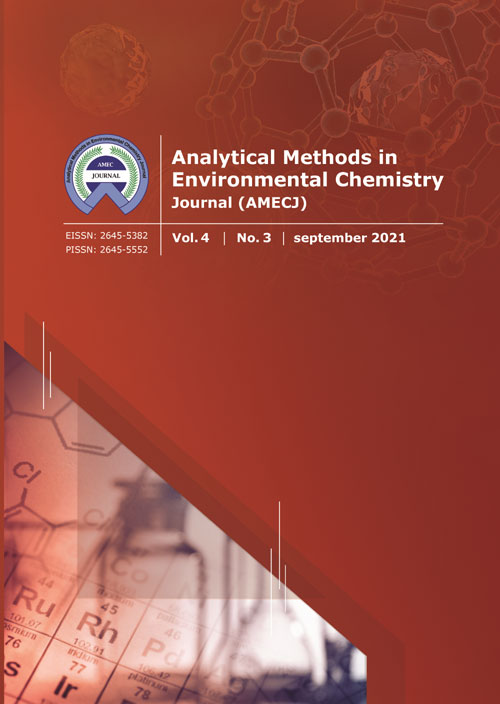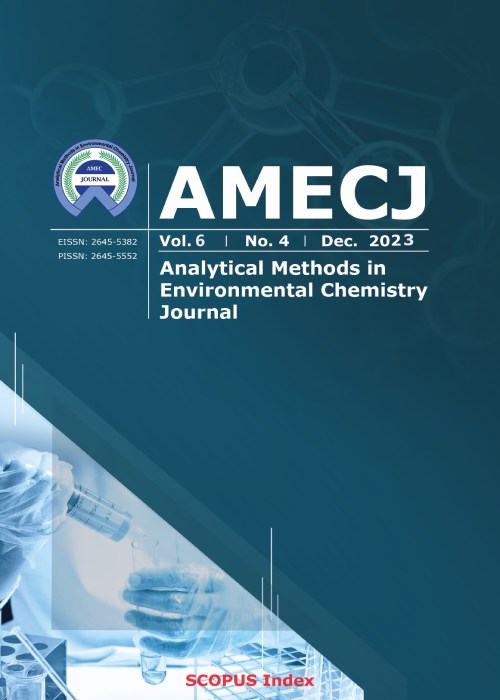فهرست مطالب

Analytical Methods in Environmental Chemistry Journal
Volume:4 Issue: 3, Sep 2021
- تاریخ انتشار: 1400/08/04
- تعداد عناوین: 7
-
Pages 5-20
Today, the safety of water resource is the most important challenges which was reported by health and environment organizations. Water pollution can be created by hazardous contaminants of environmental pollutions. Lead as a heavy metal has carcinogenic effects in humans. Metal organic framework (MOF) is a highly porous material with different application. The Zn2(BDC)2(DABCO) is a good candidate of MOF based on zinc metal (Zn-MOF) with potential adsorption/extraction. In this work, Zn2(BDC)2(DABCO) MOF as polycaprolactone (PCL) nanocomposite were applied for lead adsorption/extraction from 50 mL of aqueous solution by ultra-assisted dispersivesuspension-micro-solid phase extraction procedure (USA-S- μ-SPE) at pH=8. The samples were characterized by the FTIR, the XRD analysis, the FE-SEM and the BET surface area. The effect of parameters was investigated on lead absorption before determined by UV–Vis spectroscopy. The linear range, the detection limit (LOD) and enrichment factor of adsorbent were obtained 0.05-1 mg L-1, 0.25 μg L-1 and 48.7, respectively (r = 0.9992, RSD%=3.65). The absorption capacity of Zn2(BDC)2(DABCO) MOF for 50 mg L-1of standard lead solution were obtained 133.8 mg g-1 for 0.25 g of adsorbent. The results indicate that this nanocomposite can have a good potential to develop different adsorbents.
Keywords: Lead, Metal organic framework, Polycaprolactone, Nanocomposite, Adsorption, Suspension-micro-solid phase extraction procedure -
Pages 21-32
The cobalt compounds have adverse health effect on human and caused to damage of the DNA cells, neurological and endocrine systems. Therefore, the separation and determination of cobalt in water and food samples must be considered. In this research, the (2S)-2-amino-3-methyl-3-sulfanylbutanoic acid (penicillamine) as a chelating agent mixed with ionic liquid (OMIM PF6) /acetone and used for extraction of cobalt from 50 mL of water samples by ultra-assisted dispersive liquid-liquid microextraction (USA-DLLME) at pH=6. Based on procedure, the samples were shaked for 5 min (25oC) and after complexation of cobalt ions by thiol and amine group of penicillamine, the ionic liquid phase separated in the bottom of the conical tube by centrifuging for 3.0 min. The upper liquid phase was vacuumed by the auto-sampler and the Co2+ ions back extracted from the ionic liquid/ penicillamine in acidic pH. Finally, the cobalt concentration in remained solution was determined by atom trap flame atomic absorption spectrometry (AT-FAAS). The main parameters such as the sample volume, the penicillamine amount, the ionic liquid amount and the shaking time were optimized. The linear range, the detection limit (LOD) and enrichment factor were obtained 1.5-62 μg L-1, 0.38 μg L-1 and 98.5, respectively (r = 0.9995, RSD%=2.2). The procedure was validated by ET-AAS analysis.
Keywords: Cobalt, Water, food, Penicillamine, Ionic liquid, Ultra-assisted dispersive liquid-liquid microextraction, Atom trap flame atomic absorption spectrometry -
Pages 33-46
Agriculture waste is a good choice for the production of carbon dots owing to its abundance, wide availability, eco-friendly nature. In this study a novel magnetic bioadsorbent based on carbon quantum dots (Fe3O4-PPCQDs) from Pomegranate peel (PP) was used as adsorbent to remove lead (Pb) and cadmium (Cd) from 50 mL of water and wastewater samples by magnetic solid phase extraction (MSPE). After adsorption ions with Fe3O4-PPCQDs at pH=6, the concentration of Pb(II) and Cd (II) ions were determined by flame atomic absorption spectrometry (F-AAS). The manufactured of Fe3O4-PPCQDs and GO nanostructures were structurally characterized by scanning electron microscopy (SEM), transmission electron microscopy (TEM), X-ray diffraction (XRD) and Fourier transform infrared spectroscopy (FT-IR). The quantum dots were optically characterized by UV–Vis spectroscopy. Batch adsorption experiment was conducted to examine the effects of pH, contact time, temperature and initial concentration of Pb(II) and Cd(II) from the water. The preconcentration factor and LOD for Cd and Pb were obtained 50 and (1.3 μg L-1; 15.5 μg L-1),respectively. The equilibrium data of ions sorption were well described by Langmuir and Freundlich model. The R2 values obtained by Langmuir model were higher. The absorption capacity of Fe3O4-PPCQDs for cadmium and lead were obtained 17.92 and 23.75 mg g-1, respectively
Keywords: Carbon quantum dots, Iron oxide nanoparticles, Adsorption, Lead, Cadmium, Isotherms, Flame atomic absorption spectrometry -
Pages 47-58
Due to the persistence of polycyclic aromatic hydrocarbons (PAHs) in soil and sediments, and their toxic, mutagenic, and carcinogenic effects, the remediation of PAH-contaminated sites is an important role for environment pollution. In this study, the chemical oxidative remediation of anthracene-contaminated soils was investigated by magnetite nanoparticles (Fe3O4) catalyzed Fenton-like oxidation in the presence of hydrogen peroxide 30% (H2O2) and urea-hydrogen peroxide (UHP) at neutral pH. Urea-hydrogen peroxide (UHP), as a safer oxidizing agent, is used for the first time in the Fenton process. The magnetite nanoparticles improved the production of hydroxyl radicals, and the removal of polycyclic aromatic hydrocarbons (anthracene as a model compound) from the soil samples. The structure of Fe3O4 nanoparticles was characterized by Fourier-transform infrared spectroscopy (FT-IR), X-ray powder diffraction (XRD), scanning electron microscopy (SEM), and vibrating sample magnetometer (VSM). The removal efficiency of anthracene at an initial concentration 2500 (mg kg-1) was 95% for 2.5 mmol by using hydrogen peroxide and 93% for 0.1 mmol of UHP at the optimum oxidation condition. The anthracene reaction was analyzed by ultraviolet-visible spectroscopy (UV-Vis). The UHP safety and efficiency, neutral pH condition, the limited iron leaching and its easy magnetic separation makes magnetite nanoparticles-UHP a promising catalytic system in remediation of polycyclic aromatic hydrocarbons in contaminated soils.
Keywords: Polycyclic aromatic hydrocarbon (PAH), Remediation, Modified Fenton’s reaction, Magnetite nanoparticle, Urea-hydrogen peroxide (UHP) -
Pages 59-67
Landfills are sites designed to receive and final disposal of a broad variety of urban solid wastes (USW). The decomposition and biodegradation processes generate a leachate of high complexity and toxicity, containing persistent and recalcitrant contaminants that are not usually monitored. Bisphenol-A (BPA) is a synthetic compound applied mostly on the production of polycarbonate plastics, epoxy resins, and is an endocrine disruptor. BPA negatively affects biological receptors, resulting in harmful effects to nervous and reproductive system as well metabolic and immune function. The presence of BPA in USW urges the development of feasible analytical methods to support the effluent treatment plants and reduce the risks of contamination. The main goal of this work was to develop an efficient, eco-friendly, fast and simple method for routine analysis of BPA in the leachate from landfill. A vortex assisted liquid-liquid extraction (VALLME) using 1-octanol as solvent was performed. BPA recoveries at spiking levels of 2.5, 6.5 and 12.5 μg L-1 were between 60 to 104% with relative standard deviation (RSD) lower than 26%. The linearity of the method was evaluated and the correlation coefficient was (r) 0.9985. The limit of quantification (LOQ) was 2.5 μg L-1 with a pre-concentration factor of 20. The method has advantages such as low consumption of extraction solvent (150 μL), low cost, easy and fast determination.
Keywords: Sanitary landfill, Endocrine disruptors, VALLME, Bisphenol-A, Contaminant -
Pages 68-79
Thallium is a water-soluble metal and extra dosage has toxicological effect in human body. Thallium is readily absorbed by inhalation, ingestion and skin contact. The symptomatology of thallium toxicity was seen in patients with hemorrhage, bone/gastrointestinal problems, delirium, convulsions and coma. So, accurate determination of thallium in water and human urine is necessary. In this research, a novel and applied method based on 25 mg of nanomagnetic 4-Aminothieno[2,3-d] pyrimidine-2-thiol functionalized on graphene oxide (Fe3O4-ATPyHS@GO) was used for thallium extraction in 50 mL of water, wastewater and urine samples by dispersive magnetic micro solid-phase extraction (DM-μ-SPE). After extraction and back-extraction of solid phase by 1 mL of nitric acid solution, the concentration of thallium ions determined by flame atomic absorption spectrometry (F-AAS). The working/linear range, the limit of detection (LOD), and preconcentration factor (PF) were achieved (4-1400 μgL−1; 4-300 μg L−1), 0.9 μg L−1, and 50, respectively (Mean RSD%=1.8 water; 2.1 urine). The absorption capacity of GO and Fe3O4-ATPyHS@GO adsorbent were achieved 7.2 mg g-1 and 137.5 mg g-1 for 5 mg L-1 of thallium, respectively. The procedure was validated by ICP-MS analyzer.
Keywords: Thallium, Water, urine, Nanomagnetic 4-Aminothieno[2, 3-d] pyrimidine-2-thiol functionalized on graphene oxide, Dispersive magnetic micro solid-phase extraction -
Pages 80-106
Environment pollutants are found here and there in developing countries and these contaminations affect the environment adversely. This is done by peculation of solid and liquid substances in the dumpsites and industrial pollutions into the soil which form toxic chemicals as well as evaporation of gases into the atmosphere. Few remediation of pollution which includes incineration which is the waste treatment process that involves the combustion of organic substances contained in waste material, the waste handling practices, the recycling resource recovery, the avoidance and reduction methods, the adsorption based on nanotechnology and the bioremediation technology which appears as a cost-effective and environmental friendly approach for cleanup. Recently researches shows that various chemicals (VOCs, BTEX, heavy metals) that might be delivered into the air or water can cause unfriendly health effects which was analyzed based on sample treatments (solid phase extraction: SPE, the liquid-liquid microextraction: LLME, the magnetic solid phase extraction: MSPE) and instruments such as ET-AAS, F-AAS and GC-FID methods. The related weight of disease can be substantial, and interest in research on health effects and intervention in explicit populations and openness circumstances is significant for the development of control systems. Pollution control and determination is thusly a significant segment of disease control, and health experts and analytical chemistry specialists need to foster associations with different areas to recognize and carry out need interventions.
Keywords: Environment pollutants, Water, Air, soil, Analytical chemistry methods, Human health


